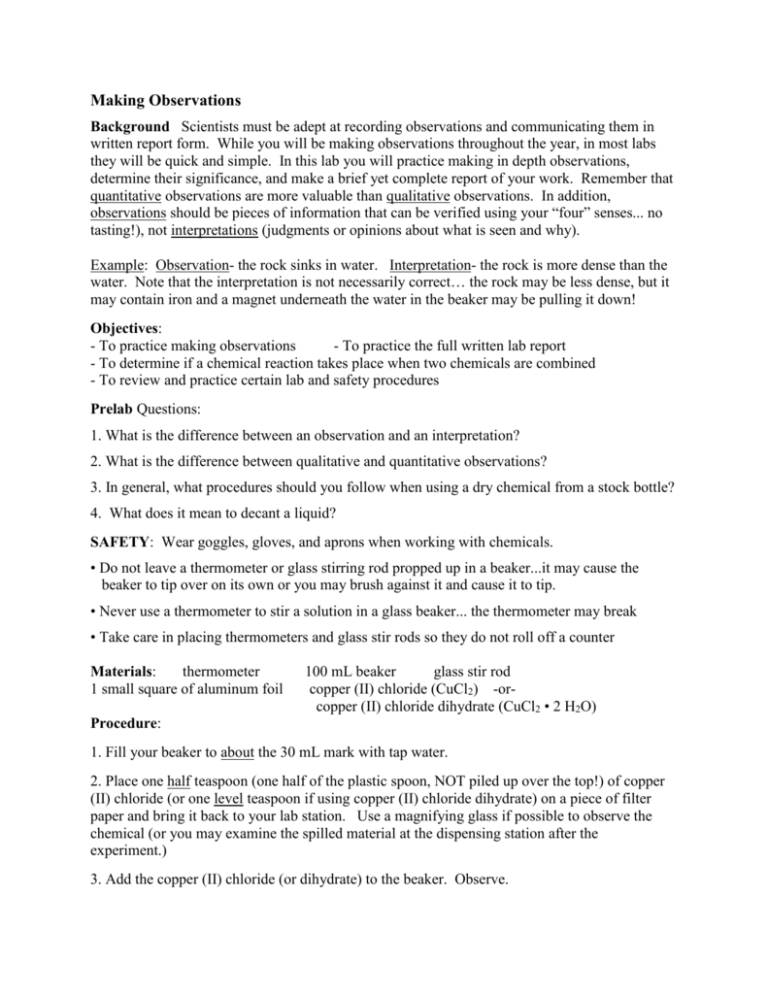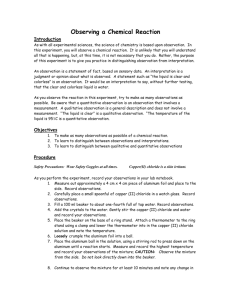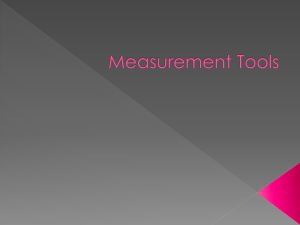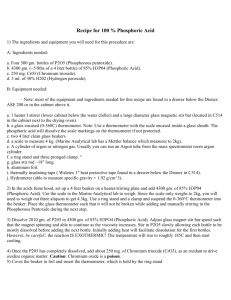Making Observations Lab
advertisement

Making Observations Background Scientists must be adept at recording observations and communicating them in written report form. While you will be making observations throughout the year, in most labs they will be quick and simple. In this lab you will practice making in depth observations, determine their significance, and make a brief yet complete report of your work. Remember that quantitative observations are more valuable than qualitative observations. In addition, observations should be pieces of information that can be verified using your “four” senses... no tasting!), not interpretations (judgments or opinions about what is seen and why). Example: Observation- the rock sinks in water. Interpretation- the rock is more dense than the water. Note that the interpretation is not necessarily correct… the rock may be less dense, but it may contain iron and a magnet underneath the water in the beaker may be pulling it down! Objectives: - To practice making observations - To practice the full written lab report - To determine if a chemical reaction takes place when two chemicals are combined - To review and practice certain lab and safety procedures Prelab Questions: 1. What is the difference between an observation and an interpretation? 2. What is the difference between qualitative and quantitative observations? 3. In general, what procedures should you follow when using a dry chemical from a stock bottle? 4. What does it mean to decant a liquid? SAFETY: Wear goggles, gloves, and aprons when working with chemicals. • Do not leave a thermometer or glass stirring rod propped up in a beaker...it may cause the beaker to tip over on its own or you may brush against it and cause it to tip. • Never use a thermometer to stir a solution in a glass beaker... the thermometer may break • Take care in placing thermometers and glass stir rods so they do not roll off a counter Materials: thermometer 1 small square of aluminum foil 100 mL beaker glass stir rod copper (II) chloride (CuCl2) -orcopper (II) chloride dihydrate (CuCl2 • 2 H2O) Procedure: 1. Fill your beaker to about the 30 mL mark with tap water. 2. Place one half teaspoon (one half of the plastic spoon, NOT piled up over the top!) of copper (II) chloride (or one level teaspoon if using copper (II) chloride dihydrate) on a piece of filter paper and bring it back to your lab station. Use a magnifying glass if possible to observe the chemical (or you may examine the spilled material at the dispensing station after the experiment.) 3. Add the copper (II) chloride (or dihydrate) to the beaker. Observe. 4. Stir the contents of the beaker vigorously and observe. 5. Roll the aluminum foil into a loose ball and place it in the beaker. Observe carefully for about five minutes... keep your head away from the beaker opening! 6. Carefully dispose of the chemicals (and pay attention- your observations may be useful). Your sample will consist of both liquid and solid. Decant the liquid into the waste beaker provided. Scrape most of the solid into the trash using a spoon. The last bit can be rinsed down the drain. Be sure to thoroughly clean your equipment and lab station. Clean your beaker well… it will leave chemical residue if you do a poor job.











